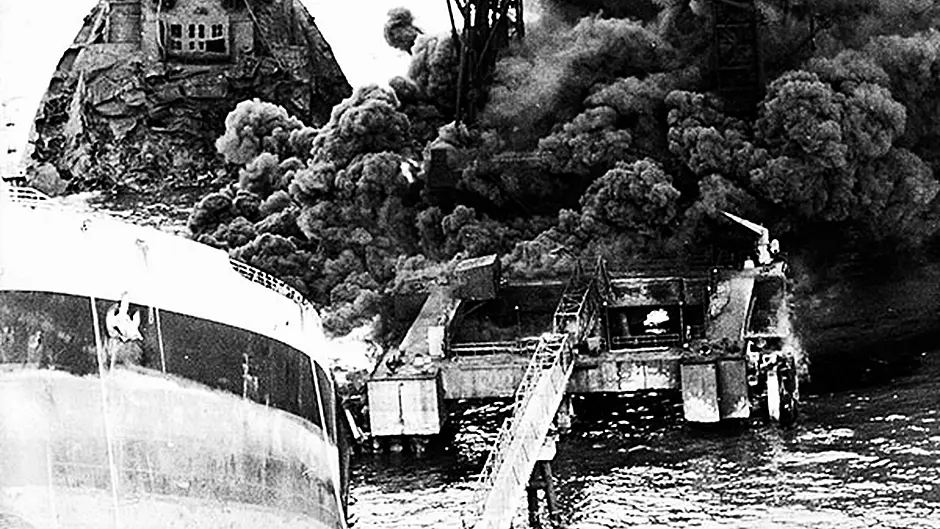I'M an able bodied sailor and I've often crossed the line On whaling ships, and sailing ships, and ships of every kind But now I got the very best job I've had for many a day I'm working on a tanker bringing oil to Bantry Bay! SO
I’M an able bodied sailor and I’ve often crossed the line
On whaling ships, and sailing ships, and ships of every kind
But now I got the very best job I’ve had for many a day
I’m working on a tanker bringing oil to Bantry Bay!
SO sang the world-famous Irish singers the Clancy Brothers in a glitzy ad, featuring a pristine, white, Universe Kuwait tanker on the rolling seas, commissioned by Gulf Oil, soon after their massive oil terminal at Whiddy Island in Bantry Bay was opened in 1969.
The last frame of the ad shows a giant tanker berthed at Bantry’s modern offshore jetty – a jetty connected to the island by the ‘Bailey Bridge’.
If that bridge had existed ten years later, the Whiddy Oil Disaster may not have claimed so many lives, or, perhaps, any.
But Gulf Oil had opted to remove the bridge a few years after installation, to allow two tankers to berth at one time, doubling the capacity at the jetty.
The lack of a bridge from the jetty to the island was just one of the many failings cited in the Whiddy Tribunal report which examined the events of January 8th 1979 – 40 years ago next week.
That was the night the French-owned tanker, the Betelgeuse, was engulfed by a massive fire, leading to the deaths of 49 men, one woman, and some months later, a diver in the salvage operation.
The Betelgeuse was no ‘pristine tanker’ – in fact it was in a ‘potentially dangerous’ condition before the event, and its poor condition is likely to have contributed to the disaster.
The protruding rusty brown bow, which suffered no fire damage whatsoever, due to the wind direction on the night, was evidence of how poorly maintained the entire ship had been.
A technical photographer, who had taken pictures of the Betelgeuse just hours before the fire, later said that it was a ‘bloody awful looking ship’ and local journalist Peter Tynan O’Mahony, who had been spotting it from his home in Bantry, said that even from a distance it looked ‘rusty and ramshackle’.
JUST before the terminal was built in 1969. a young RTÉ reporter named Bill O’Herllihy travelled to Bantry to talk to the locals and those involved in bringing Gulf Oil to West Cork.
Fears of a major disaster at the terminal were dismissed by those in authority, who said their concerns were allayed by Gulf’s many reassurances that all possible safety methods would be in force at the terminal.
In fact, the bigger fear at the time was the fear of pollution, but O’Herlihy’s report appeared to come to the conclusion that some pollution was an occupational hazard in any port where there is a large oil terminal, but it would be a small price to pay for the ‘economic boom’ that the terminal was likely to bring to the town.
That economic boom was short-lived, because after the disaster, just a decade later, the terminal’s future was sealed.
Today, Whiddy is used for storage of part of the national oil reserves and the activity there is a fraction of what was seen in the bay in its heyday.
And while, in the decade prior to the Whiddy disaster, there were, in fact, many instances of significant pollution, they were largely forgotten after the enormity of what happened on Monday, January 8th 1979.
ON the night of the disaster, Whiddy islanders James (since deceased) and Noreen O’Leary and their daughter Mary had gone to bed. Their house was about one-and-a-half miles from the jetty.
James’ bedroom window had a partial view of the jetty.
Mary O’Leary was asleep but was woken up by a ‘rumbling sound’, she told the Tribunal. It was a sound which she found difficult to describe.
It was not like thunder, but more like a ‘rumbling or banging — a repeated banging noise’.
She got out of bed and saw black smoke. Initially she saw no flame, but after about thirty seconds, flames began to appear in the smoke. They got bigger.
At first, she was not alarmed by what she saw, as she thought it was the ordinary smoke that tankers let off. But then she saw the size of the flames.
She went to her parents’ room and woke up her father. ‘Daddy, there is something wrong with Gulf. It’s on fire,’ she told him.
As he got out of bed he looked at his watch, noting: ‘It’s a quarter to one.’
From his window he could see the tanker and the centre platform of the jetty. There was fairly intense smoke, which ‘seemed to come out of one patch’, he remembered.
He immediately got dressed and went with his son to a field at the back of the house, a few hundred yards away, to get a better view of the fire. At first, the smoke was not heavy, but as the minutes went by, both the smoke and the flames increased and blocked his vision.
He decided to travel down to a small rock off the island known as Carrigacloash.
When he got down to sea level, the fire was very extensive. ‘The whole area was covered in flame,’ he remembered.
He was only there for a few seconds when the big explosion occurred. He was stunned by it for a couple of minutes, and debris fell around him. He was ‘absolutely terrified’, he said.
He returned to his house and gathered up his family to get off the island. At no time did he hear a warning siren.
He estimated the big explosion as having occurred between 1:05am and 1:10am.
This was to prove critical to the Tribunal, as were all the testimonies regarding time. A number of Gulf employees stated there was no fire until about 12:50am, just before the large explosion.
But the Tribunal found several witnesses, with vantage points all around the bay, who had seen flames from as early as 12:35am and 12:40am.
Mrs O’Leary corroborated her husband’s testimony in relation to the time he was awoken. She remembered a telephone call from the post office, which she received after her husband had got dressed and left. She could not be certain as to the exact time, but she checked later and the postmistress told her that she had booked the call to her at 1am.
The message she got from the postmistress was to the effect that John Connolly, the Gulf dispatcher on duty in the control room that night, had telephoned and he wanted the men collected to go down and help fight the fire.
Noreen said she would normally hear a siren at the terminal when it went off, but she did not hear one that night.
When the Tribunal’s report was published 18 months later, it was very critical of a number of Gulf employees.
It concluded that Gulf management didn’t tell the truth about what happened on Whiddy that night.
And they had earlier made changes – only one man in the control room for a 12-hour shift; changes in firefighting equipment; changes on the jetty; changes on the tugs, (which were located 20 minutes’ away) – without enough thought of the consequences.
The 508-page report rocked Bantry, and left a very sour taste in the mouths of those who had earlier put their faith in the oil company to transform the town’s fortunes.








